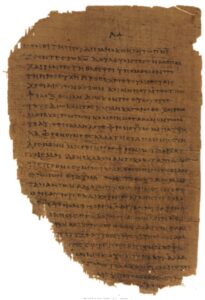Tyler L.
The use of papyrus as a writing material originated in Egypt and has been traced back to A.D. 2500. In the new testament days it was still a very popular writing material, making it the primary source of biblical writings (wikipedia) The papyrus “paper” was from the Egyptian papyrus plant and scrolls of papyrus were rolled out horizontally rather than vertically. The scrolls were approximately 10 inches high and up to 35 ft in length with texts written in columns of about 2 1⁄2 inches wide and just over 1⁄2 an inch apart from one another. Usually the text was written on only one side of the scroll (Coptic Orthodox Diocese 501) There are in fact over 130 biblical papyri known to date. But just where are these papyri held? In various places around the globe, to name a few places in which these manuscripts are held here is a short list: Bodmer Papyrus 11 in the Bodmer Library, Chester Beatty papyri at the Chester Beatty-museum in Dublin, and others in the Vatican Library, British Library, Cambridge University Library, and the Bibliotheque Nationale in Paris etc. (Gerber 1). The earliest of these papyri is the gospel of Mark (P137) which dates back to 150-250 AD.
The papyri was relatively easy and cheap to produce which made it a popular use of writing material but its downside was that it was fragile and susceptible to both moisture and excessive dryness. This makes it so that the writings on early papyrus are few and far between. With this rarity there was bound to be collectors of sorts, the most notable and influential in regards to the old and new testament papyri collections is a man named Chester Beatty. He acquired the group of papyri over his lifetime most likely from dealers in illegal antiquities which made it difficult to decipher the exact circumstances of the findings of the artifacts.These third century papyrus codices Also known as “P45,” “P46,” and “P47,” are housed in Beatty’s gift to the world: the Chester Beatty Library in Dublin, Ireland. (Sheri Bell 1) There are eleven manuscripts in the group, seven Old Testament book and three of the New Testament. With this collection there is a large amount of worth that comes from a collection such as this. Chester Beatty Papyri was no doubt an important tool in relation to Uncial texts as to the more accurate dating of manuscripts (not just the biblical manuscripts) due to the sheer age and relation to many other manuscripts of similar age or later. It also allowed for a better pinpoint on the more minuscule writing as well as cursive techniques that were so common in New Testament manuscripts.

Papyrus “P46”, containing Romans 12: 11-13:1 (image Museum of the Bible)
For the Christian population these scripts hold even more significance in regards to the accuracy of the current bible as well as other manuscripts. The more texts that are found or gathered, the more precise and bonafide the writings can become. The image above is a papyrus manuscript of the book of Romans chapter 12 verses 11-13 and is one of the Chester Beatty collection. It truly is a magnificent piece of history. With the addition of this papyri along with so many others it validates the religious texts that believers affirm, at least towards the texts historical accuracy. Also, Israel’s biblical roots have been validated through archaeological discoveries dating back over 3,000 years. Time and again, another piece of history is found that proves the continuous Jewish connection to this land from ancient times until the modern era. This growing wealth of archaeological evidence validates Israel’s biblically mandated right to exist as a Jewish state (CUFI 1).
Maybe the most important of all is the contribution of the papyri to a deeper knowledge of ancient life. This is found in the writings about and by different biblical characters. Often a strong emphasis is cast on the social wrongs of the time, essentially detailing the social context of the ancient time. Included are accounts of different classes or types of people giving a plethora of resources on everyday life from the child, the prodigal, the Jewish money lender, etc. (James Orr 1) The inner workings of ancient societies is always a topic of debate and resources such as the biblical papyri help in decoding the ways of the past. It is no doubt that the worth of this historical interpretation is great.
Works Cited
“8 Ancient Manuscripts That Validate the Bible’s New Testament.” Josh.Org, 24 Jan. 2018, https://www.josh.org/8-manuscripts-validate-new-testament/.
“Biblical Basis.” Christians United for Israel, https://www.cufi.org/learn/issues/christian-support-of-israel/biblical-basis/. Accessed 19 Oct. 2018.
“List of New Testament Papyri.” Wikipedia, 19 Sept. 2018. Wikipedia, https://en.wikipedia.org/w/index.php?title=List_of_New_Testament_papyri&oldid=860299781.
Manuscripts – Early Bible Papyri. http://earlybible.com/manuscripts. Accessed 12 Oct. 2018.
Papyrus Definition and Meaning – Bible Dictionary. https://www.biblestudytools.com/dictionary/papyrus/. Accessed 12 Oct. 2018.
Where Are the Original Manuscripts of the New Testament of the Bible Being Kept? Are They Still Existing? – Quora. https://www.quora.com/Where-are-the-original-manuscripts-of-the-New-Testament-of-the-Bible-being-kept-Are-they-still-existing. Accessed 19 Oct. 2018.
“Writing Materials Used for the First Holy Bible – Interesting Facts – Resources.” Coptic Orthodox Diocese of the Southern United States, http://www.suscopts.org/resources/interesting-facts/14/writing-materials-used-for-the-first-holy-bible/. Accessed 12 Oct. 2018.